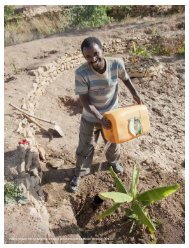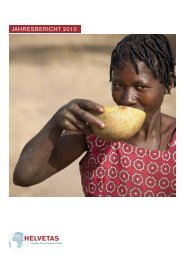Report Feasibility study organic bitter tea Cao Bang - Helvetas
Report Feasibility study organic bitter tea Cao Bang - Helvetas
Report Feasibility study organic bitter tea Cao Bang - Helvetas
You also want an ePaper? Increase the reach of your titles
YUMPU automatically turns print PDFs into web optimized ePapers that Google loves.
<strong>Feasibility</strong> Study Organic Bitter Tea in <strong>Cao</strong> <strong>Bang</strong>: 2007<br />
maximum limits, exporters are required to obtain an import tolerance. It should be noted<br />
that the EU continues to lower the maximum limits of pesticide residues permitted in<br />
products (FAO, 2007).<br />
In Japan, the Ministry of Health, Labour and Welfare and the Environmental Department<br />
are responsible for establishing and testing residue limits. These limits are based on the<br />
Food Sanitation Law (FAO, 2007).<br />
5.1.2. Product traceability<br />
In response to recent problems about food safety (e.g. mad cow disease) and global<br />
terrorism, many governments are increasing control over all stages of food production,<br />
processing and distribution to protect consumers against the biological, chemical and<br />
environmental contamination of food. Traceability (product tracing) is the ability to follow<br />
the movement of food through specified stages of production, processing and distribution.<br />
They also enable efficient recall in case of the products' contamination. Furthermore, they<br />
help determine the origin of a food safety problem, comply with legal requirements and<br />
meet consumers' expectations for the safety and quality of purchased products (FAO,<br />
2007).<br />
The EU regulations on traceability entered into force in January 2005. In order to comply<br />
with these rules, it is important that EU importers identify the origin of products. As a<br />
consequence, the latter could require exporters to comply with traceability requirements<br />
even if the exporter in trading partner countries are not legally required to fulfil the<br />
traceability requirement imposed within the EU. No traceability requirements for exporters<br />
exist in Japan yet (FAO, 2007).<br />
5.2. Organic regulation and procedures<br />
5.2.1. EU <strong>organic</strong> regulations and procedures<br />
In 1991 the EU passed a regulation about <strong>organic</strong> farming. This regulation EEC Regulation<br />
2092/91 contains the legal provisions regarding farming, labelling and monitoring of<br />
<strong>organic</strong> farming for the whole European Community. The Regulation provides the basic<br />
standard for <strong>organic</strong> plant and livestock production and, at the same time creates specific<br />
requirements regarding farming, processing and importation from third countries. All farms<br />
and processing units are submitted, at least once a year, to a programmed inspection. As<br />
well, unannounced random inspections are carried out. The costs of inspection and<br />
certification are to be paid by the company requesting the service.<br />
A European logo for <strong>organic</strong> products exists since February 2000.<br />
However, the use of this label is not mandatory and for now is still not<br />
commonly used.<br />
If an operator in a country outside the EU wants to export <strong>organic</strong><br />
products to the EU, then a certification body (CB) must perform on-site inspections. In the<br />
case of Vietnam, where local <strong>organic</strong> certification bodies do not exist, an international<br />
certifier has to be selected. This could either be one based in Europe or one with a branch<br />
office in Vietnam. Currently, there is only one CB with an office in Vietnam, while several<br />
other CBs use local or regional inspectors.<br />
The EU does not have specific environmental or "low pesticide" food labels and<br />
regulations (although some regulations exist at the national level of the individual EU<br />
- 17 -










